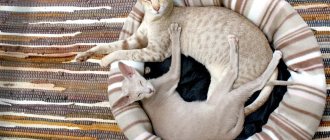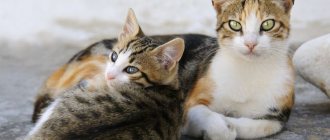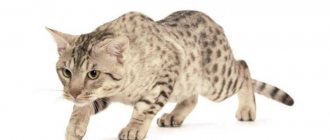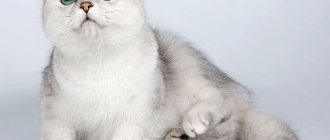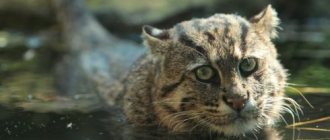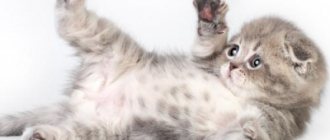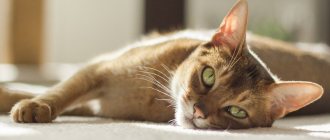Photos with the caption “Georgian cat” are increasingly appearing on the Internet. Indeed, the animal has a spectacular oriental appearance: large ears, a long nose and expressive eyes. In fact, this cat breed has a completely different name and, in addition to its similarity with Georgians, has a lot of remarkable characteristics.
History of the Oriental cat breed
Oriental cat
Genetically, oriental cats are close to the Siamese, with whom they began to be exported from Thailand in the 19th century. British breeders did not consider (or did not want to consider) green-eyed cats as an independent breed, so they classified them as a classic Siamese with a modified type of color. It is worth noting that at European exhibitions Orientals were not particularly favored, systematically disqualifying mustachioed emigrants either for non-standard colors or for the emerald shade of the iris.
The animals also did not arouse much interest among potential owners, so until the beginning of the 20th century, Oriental cats were bred only by enthusiasts who were passionate about breeding activities. The real crisis fell on the Thai Eared Cat in 1923, after the American Siamese Cat Club strictly tabooed the breeding of any variety of pets, with the exception of blue-eyed individuals with the Himalayan color.
For almost 30-odd years, Orientals were in limbo: they were expelled from the Siamese clan, but were never recognized as an independent breed. They remembered the cat only in the 60s by British and American breeders, who were carried away by the extreme appearance of animals. Initially, breeders planned to develop another variety of Siamese cat, which would have a uniform coat color, but would not lose the grace of its lines. To achieve this goal, Orientals began to be crossed with Abyssinians and other short-haired breeds.
1977 was a landmark year for Orientals, in which the wards of American breeders received their own standard of appearance. By the way, the first set of breed characteristics developed for overseas murkis was almost completely copied from the Siamese standard (with the exception of the points “body” and “colors”). But in Britain they were in no hurry to honor Asian cat breeds and spent 20 long years looking closely at them, scrupulously weighing the pros and cons. As a result, English long-eared cats were able to become an independent breed only in 1997, after official recognition by the GCCF.
Oriental cat with cat
Black oriental cat
Origin story
The origin of the Oriental cat has a branched family tree. The first mentions of the breed were seen in manuscripts. For a long time, Thailand was considered the homeland of the Georgian cat. Then England became interested in these representatives of felines, and in 1974 it was officially registered.
Oriental cats are sociable, feel attracted to people and get along well with them. The pet will be loyal and become not just a companion, but a true friend for the owner. Cats get along well with other animals. But they can also show leadership by defending territory. In this case, there is no need to worry. Aggression will be shown only in exceptional cases. Georgians have well-developed intuition. They understand the owner’s mood and try their best to adapt to it. With such a pet you will achieve mutual understanding. He will understand you like no one else.
Oriental cat loves to talk out loud and out loud
This is a very active animal that is quiet - it will not sleep peacefully next to you all the time. The cat will begin to look for adventures, playing with everything that comes under his paws. Georgians can show their temperament and perseverance. Therefore, you need to be prepared for the manifestation of this side of character.
Owners of Oriental cats describe them as affectionate and intelligent pets. Some of them are quite noisy. This is caused by a playful and active nature. Many people compare Georgian cats to dogs.
They are just as loyal and constantly demonstrate their sincere love with constant attention. Orientals - love for life. Full of affection, kindness and care
Full of affection, kindness and care.
Appearance of Oriental cats
The Georgian cat has a long body. Graceful lines create the image of an aristocratic animal. The tail is long. The head is large, triangular in shape. There is no smooth transition from the forehead to the nose. The cat's profile is even. The eyes are large, close-set, almond-shaped. Eye color is related to coat color.
Attention! Strabismus is considered a pathology of this breed. Big nose
There is no depression on the bridge of the nose. The kitten may have a slight indentation, but it will disappear over time
The nose is big. There is no depression on the bridge of the nose. The kitten may have a slight indentation, but it will disappear over time.
The ears occupy a sufficient area at the base, are large and widely spaced.
The length of the Oriental's limbs is above average. The bones are thin but strong. Oval shaped paws.
The coat is quite short, silky, and not prone to shedding.
Where did the Orientals come from?
History of the breed
Oriental cats were first mentioned in ancient manuscripts of Thailand. Scientists have discovered images and descriptions of fully colored shorthaired cats. At the same time as Siamese cats, these animals were brought to Europe in the 19th century. In 1896, an exhibition was held in England where the blue oriental cat from Bangkok was presented for the first time. However, Siamese cats, which aroused great interest with their color, eclipsed their relatives for some time. Only in the 60s did breeders again show interest in solid-colored oriental cats. To create the breed, Siamese cats were crossed with fully colored shorthairs.
The Oriental cat breed was officially recognized in the early 70s of the 20th century; in 1974, the standard was finally edited in England. In the USA, a preliminary standard was adopted back in 1958. In 1974, animals of a new breed began to be registered; by the time Oriental cats were officially recognized, there were about 60 nurseries. Representatives of this breed came to Russia quite late, in 1987, but with their unusual appearance and devoted character they won the hearts of people.
Today, Siamese and Oriental cats are part of a single breed group and have a common standard. Orientals were originally called “solid chocolate Siamese.” In 1971, a variety of cats was developed that became known as Havanese. This nickname was due to the fact that the coat color of the species was very similar to the color of Havanese cigars; such cats have a lighter and more elegant physique and a different eye shape. The ebony variety of oriental color is also very beautiful - the coat of such cats has a rich black color, even the paw pads are black. In 1965, white Orientals were registered in the USA; their coat must be snow-white, without the slightest sign of yellowness. In 1972, Lavender Orientals were bred with light gray coats with a slight pink tint. There are also blue, red, cream, and tortoiseshell cats.
Most of the color variations of Orientals are tabby patterns: mottled, marbled or brindle.
Permanent color is established only in the 2-3rd year of a cat’s life; it is very important that there are no white spots on the body
Description of the breed
Like any representative of the species, an Oriental cat must meet a certain breed standard. Compliance with regulations is especially important for owners planning exhibitions and breeding of animals. But even someone who takes an Oriental just as a companion needs to understand what a pet should look like.
Appearance - what an oriental looks like
The head is of medium size and clearly proportional to the body. The shape resembles a wedge with straight lines. The wedge starts from the nose and gradually widens towards the ears. When viewed in profile, a slight convexity of the skull is determined. The forehead is flat. The ears are large, set wide and directed straight, at an angle in relation to the head. They are wide at the base, but the tips become pointed. The eyes are medium in size, almond-shaped and slightly slanted towards the nose. The classic shade is bright green. The nose is long and straight.
The neck is long, with a smooth transition into the line of the back. The body is long, with clearly defined muscles, but graceful. The limbs are slender and proportional to the body. The paws are oval shaped and quite small. The tail is thin and long, tapering towards the tip, reminiscent of a whip.
Today, according to their appearance, Orientals are divided into two types: classic and extreme. Extreme type cats have low-set ears and a very elongated muzzle.
Size
Normal height at the withers for an adult Oriental is considered to be between 23 and 25 cm. The body can be up to 90 cm long.
Weight
The average weight of an adult cat of the Oriental breed ranges from 3.7 to 4.5 kg. The normal weight for a cat ranges from 2.3 to 3.2 cm.
Wool
The breed is short-haired, the hair is fine and shiny. All fur should lie close to the body and be silky to the touch. There is practically no undercoat.
Colors
The classic colors of Oriental cats are:
- Ebony is a black shade of wool, also called black solid.
- Bronze - the shade resembles bronze, but a bright red color is acceptable, closer to red, while the paw pads and nose are soft pink.
- Lavender - this color is also positioned as lilac, the paws and nose are lavender, sometimes their shade is closer to pink.
- Havana is a classic chocolate color, can vary from light to dark brown, paws are brown-pink, nose is brown.
- Blue - a combination of gray-blue with a slight shade of silver, paw pads and nose are blue.
- Cream or fawn - includes fawn (beige coat) and cinnamon (shades of red or very light brown), paws and nose should be pink.
- Tortoiseshell or tri-color - it combines white, black and red wool.
- White is a unique color without a yellow tint, the paws and nose are soft pink, the eyes can be not only green, but also blue, or heterochromia may appear.
In addition, Ories can have a tabby color (the presence of spots, flats, marbled patterns, etc.) on top of the main shade of the coat.
What is the difference between Orietal and Siamese cat breeds?
Orientals are often called rainbow cats: there are more than 300 variations of coat color. The Oriental breed has virtually no genetic diseases
What is the difference between Orietals and Siamese: Oriental and Siamese cat breeds are the same thing. These breeds have an absolutely identical description in the standards of the whole world and differ (depending on the felinological system) only in color. Most European systems distinguish the Siamese breed from the Oriental breed by the presence of a point color (or, more understandably, by the animal’s light, uncolored body and blue eye color). Oriental cats have a fully colored body and green eyes. There are no other differences, and the character is no exception; it is also very similar in these cats. Of course, we should not forget that each cat has its own unique character traits, just like a person, each cat is an individual.
In connection with what was written above, I will further use the name “Orientals” to mean both Siamese and Oriental cats. So, Oriental cats are very lively, active, curious, affectionate and sociable.
Orientals have a great need for human attention and communication with them. Oriental cats also love the company of tailed cats, regardless of whether it is a cat or a dog. However, they achieve the greatest harmony in relationships only with their own kind or with light-type cats that are similar in temperament.
Every minute while the owner is at home, they will entertain him with their agility, their elegant jumping, talking, playing with the mouse, or simply sharing a seat with him in front of the TV. Oriental cats really don’t like to be left alone, so they are ready to circle around a person most of the time
The greatest happiness for an Orika (as we affectionately call this breed) is play with the participation of the owner, no matter what you choose for the game, a teaser with feathers or a laser pointer, or maybe just decide to play hide and seek!
The owner of the oriental cannot sleep longer than the alarm clock, you will certainly be reproached for this, because the moment has come when you need to communicate, and you are still sleeping. And if you stay up late at the computer, your pet will definitely remind you of the routine and invite you to sleep. The talkativeness of this breed is, of course, a subject for another discussion. Owners know absolutely exactly what their pet is communicating. Orientals use a very large number of sounds and intonations in communication, and therefore, communication with them turns into a real dialogue.
The most striking feature of Oriks is their ability to greet their owner from work. It’s as if from the very moment you closed the door behind you, leaving for work in the morning, he, unhappy, sits there and has already looked through all his eyes, waiting for his beloved owner! He will definitely express his opinion that working for so long is harmful (for the Oriental’s psyche), and then he will check all the packages that you brought from the store in order to find out if there is anything for him.
Another inseparable trait from an oric is curiosity. Often it is so large that even the most cowardly Orik will crawl out of the lair to see what is going on “there”. By the way, this is why in their upbringing we often have to remind them that this cannot be done even today. And check the order in your closets, oh, that is, in his closets, of course! Open the door or drawer of the cabinet, in which perhaps something interesting, or maybe even tasty, is hidden... yes, an Orientalist definitely needs this!
Curiosity does not leave the orik even when guests come to the house. Not only does it not leave, it grows in them with every new guest! They select keys for each new person. The most striking feature of orics is the ability to make people who do not like cats at all and do not understand them fall in love with them.
Another important characteristic feature of Oriental cats is the ability to have several coordinate points in an apartment at once. It seems like he was just walking along with his tail and was so carried away by this, when suddenly a rumble comes from another room, and you turn around - he’s sitting here and washing himself! Imagine how problematic it is when there are several of them of the same color!
Oriental company is a great joy. With Orientals it is never boring to do troublesome household chores, because you don’t have to do anything alone. Truly, you are flying home, because he is bored and completely lonely there. This is exactly how you start to get excited about oriental cats and acquire a second oric for your company, sometimes then a third, and a fourth, etc.
How to choose a kitten
When choosing a nursery, you need to pay attention to some facts. For example, good breeders do not sell babies under three months of age. Kittens should be kept in an apartment on the same basis as adults. Aviary or “indoor” babies communicate less with people, so they adapt less well to new conditions and have a harder time making contact with their future owner.
Responsible breeders are happy to answer all questions related to feeding, maintenance, documents, and raising pets. If the kitten does not have a mother, then most likely it is a mestizo, which they are trying to sell under the guise of a purebred animal.
If a career with exhibitions and matings is planned for the baby, it is worth visiting nurseries with breeding class kittens. The parents of such babies have a very impressive pedigree with many titles. But if you plan to buy a “cat for a pillow,” then it is better to visit nurseries that sell babies without breeding rights. Typically, breeders sell already neutered individuals or offer to sign an agreement on mandatory castration at the age of 8 to 12 months.
Cost of kittens
The price of a kitten depends on many factors. The decisive role is played by the presence of a pedigree, the class of the pet, coat color, the possibility of breeding, the type of mating (foreign or local), as well as the remoteness of the nursery.
Approximate cost depending on the class of kittens:
- Pet class (per pillow) from 25 to 40 thousand rubles.
- Breed class from 50 to 70 thousand rubles.
- Show class from 70 to 120 thousand rubles.
Oriental catteries
The most popular Russian oriental nurseries are located in Moscow and the Moscow region:
- Avatar nursery is located in the Moscow region.
- Moscow nursery JUNGLE, registered in WCF and FIFe. Specializes in Orientals, Siamese and Seychelles.
- Salambo is a cattery of Siamese and Oriental cats in Moscow, registered with WCF.
- The MASCOT nursery is registered with FARUS and is located in Moscow. Specializes in oriental cats.
- Moscow cattery of oriental cats Liberty World. Registered with WCF.
Appearance of an oriental cat
Orientals are typical Asians: graceful, lean, with the hypnotic power of a jade gaze. A distinctive feature of these charismatic pussies is their phenomenal plasticity of movements, thanks to which even ordinary stretching in their performance turns into a full-fledged yoga master class. Based on their coat type, Oriental cats are divided into short-haired and long-haired. The latter variety was born in the 60s of the last century as a result of crossing a shorthaired Oriental with a Balinese (Balinese cat). The Oriental Longhair was introduced as an independent breed in 1977, but it was only able to confirm its worth at exhibition competitions in 1997.
Head
Oriental kitten
According to the standard approved by the WCF (World Cat Federation), the head of an Oriental must have a flat forehead and a prominent profile. The muzzle of representatives of this breed should be narrow, and the chin line should be clearly defined. A mandatory item is the wedge-shaped shape of the skull.
Eyes
Almond-shaped, slightly slanting. The distance between the eyes is visually equal to the length of one of them. Regardless of coat color, all Orientals have rich emerald eyes. An exception to the general rule are white-haired individuals, whose iris color may be blue. Some cats have heterochromia (different eyes).
Ears
Quite massive in relation to the head. The ear flap is thin and wide, continuing the wedge-shaped line of the cat's muzzle. The tip is slightly rounded. The most intensive growth of the ears is observed in the first months of the animal’s life, which is why the Oriental kitten resembles a hybrid of Cheburashka and Yoda from Star Wars.
Graceful, elongated type.
Oriental cat face
Torso
Slender, noticeably elongated in length, with a well-developed muscle corset. The constitution of the body is close to lean: the animals look elegant and graceful.
Oriental longhair cat
Oriental cats have extremely long limbs, giving their silhouette a slight aristocracy and grace. The animals' paws are oval and relatively small.
Wool
Oriental cats have virtually no undercoat, allowing the fur to softly outline the contours of the body. The hair of short-haired individuals is shiny, satin-type. Long-haired animals have thin, silky hair. Since representatives of the second type have hair that fits tightly to the body, its real length is partially “lost.”
Color
Curled up into a ball
What the breeding experts were most loyal to were the color options for Orientals. Today, this is one of the few cat breeds that has the right to almost any shade of all existing ones.
In order to systematize the “colors” of eared cats, their basic types were identified by felinological associations. In particular, modern Oriental cats can have coats of such colors as:
- lilac (lavender);
- blue;
- red;
- Havana (brown);
- cinnamon (cinnamon);
- faun (beige);
- ebony (black);
- cream;
- white.
The preferred tabby colors are merle, brindle, ticked and spotted.
Defects and disqualifying defects of the breed
Serious defects that spoil the aristocratic appearance of Oriental cats include strabismus, any shade of the iris except green, as well as protruding and clearly palpable cartilage in the sternum area. As for exhibition events, first of all polydacts, very small or too thin individuals and cats with kinked tails will not be allowed to attend. The list of defective pets includes animals with insufficiently strong hind legs, spots on the fur in the form of medallions, as well as cats that breathe through their mouth. In the long-haired variety of Orientals, a double coat with a well-developed undercoat may be a reason for disqualification.
Possible rock defects
Judges will not allow oriental cats to participate in championships and exhibitions if they have the following defects in appearance:
- - kinks on the tail,
- - extra toes,
- - the iris is not green (this does not apply to white cats),
- - signs of cryptorchidism,
- - presence of undercoat,
- - color not meeting the standard,
- - ears are not big enough
- - too slanted eyes
- - poorly developed muscle corset,
- - body fullness,
- — white medallions are visible on the wool.
Caring for Oriental cats with a nose like a Georgian
What to feed
When choosing a brand of dry food, give preference to “super premium” lines; they will replenish the balance of essential vitamins and microelements, making the diet balanced and the pet’s appearance well-groomed. Read more about feeding.
It is recommended to give preference to feed from the following manufacturers:
- Royal Canin labeled healthy food,
- Hills for active breed cats.
Rules when creating a menu for a pet:
- for coat care, it is recommended to give Orientals 2 drops of melted butter as an additive to their main food;
- foods high in fiber should be excluded;
- the presence of fats in food is necessary (about 20% of the total diet), the amount of carbohydrates can be reduced (2-3%), proteins make up up to 50%;
- from meat you need to give beef, chicken, turkey, rabbit from a trusted supplier and of high quality;
- boiled sea fish, strictly without bones, 1-2 times every 7-10 days;
- exclude dairy products from the menu of an adult cat, this leads to diarrhea.
You should always make sure there is fresh water in your cat's bowl!
The Oriental's feeding schedule depends on its age:
- Kittens are fed 5-6 times a day;
- Growing individuals should be given food 3-4 times (9-12 months);
- adult cats are fed more often 2-3 times depending on the amount of food and menu items.
How to care for claws, eyes and other body parts
The Georgian cat, in accordance with the standard, has short hair, without undercoat, which does not require special care, you just need to maintain a balanced diet, do not give the cat harmful foods or cheap dry food.
It is not recommended to bathe Orientals:
- firstly, they take excellent care of their fur;
- secondly, they do not like water treatments; contact with water can be stressful for the pet.
To care for your claws, you need to take the following measures:
- be sure to purchase a scratching post and teach your Oriental to use it from a young age, otherwise overgrown claws will become a problem not only for the cat, but also for yours;
- If the claws continue to grow, you should carefully cut off the long part of the claw in the place where there are no blood vessels using special scissors.
The outside of the ear must be systematically inspected and cleaned with soft cotton wool ear sticks. The procedure is carried out once every 10-14 days.
If you notice dark-colored discharge, contact your veterinarian immediately!
Representatives of the breed are very sensitive and prone to gum inflammation, so caring for the cat’s mouth should be carried out regularly from a young age. To do this, teeth are brushed 2 times a week using a children's toothbrush and a special paste.
If inflammatory processes occur on the gums, you should immediately contact your veterinarian!
Bowls should be kept in exemplary cleanliness, do not forget to wash them as often as possible.
At what age should vaccinations be given?
Vaccination of Orientals and Siamese cats is carried out according to the same schedule:
- 9 weeks;
- 12 weeks;
- 15 weeks;
- 6 months;
- 12 months.
Before vaccination, it is necessary to examine the general condition of the animal, undergo a preparation procedure, including timely distribution of anti-worm medications (carried out in accordance with the veterinarian’s recommendation 7-14 days in advance).
Every year, Oriental cats must receive the following vaccinations against:
- panleukopenia;
- calicivirus;
- rhinotracheitis;
- leukemia virus;
- rabies.
What pet diseases can an owner encounter?
The average lifespan of a cat similar to a Georgian is from 12 to 15-16 years
The cat’s health depends on quality care, because many diseases can be prevented at an early stage if you pay due attention to your pet
The Oriental cat has fairly good health, but is prone to inflammation of the gums, the tissues that surround the teeth.
Prevention of gingivitis and periodontitis is mandatory; for this you should follow hygiene procedures and regularly visit a veterinarian who examines the animal!
Often representatives of the breed have common diseases with Siamese cats: heart problems, kidney disease, manifestations of liver failure.
Remember, an annual examination by a veterinarian is mandatory for cats 7 years of age and older!
Life expectancy and health
Georgian cats live on average 15–16 years, and some individuals live 18–20 years. Although they have good health, animals are still prone to some hereditary diseases:
- cardiomyopathy;
- liver amyloidosis;
- retinal atrophy;
- flat chest syndrome.
Oriental cat care
Even with all its exotic appearance, the Oriental cat is not demanding in care. Their unpretentiousness is another reason why the animal has won such love from fans. Even scratching should not be too frequent. You can keep your coat looking beautifully shiny simply by regularly using a rubber glove. Grooming involves examining the ears, eyes and claws.
How to properly care for your ears and eyes
Eyes should be wiped clean of discharge every day. To do this, you can use a cotton pad or soft cloth. It is recommended to carry out the procedure using tea leaves or warm water. Oriental ears do not require special care. Delicate and sensitive skin should be cleaned with cotton swabs soaked in Vaseline, vegetable or special oil. During the procedure you need to be very careful, not to make unnecessary movements or sudden pressure.
Features of hair care
Short-haired representatives are very easy to care for. You need to comb them at least once a week, changing brushes to remove dead hair. The frequency of brushing for long-haired Orietals should be greater so that the hair does not get tangled. There is no need to wash your pet often. In winter you need to bathe as little as possible, and in summer - when dirty, but not more than once a month.
Preventative nail care
At least once a month it is necessary to trim the animal's claws. You need to do this so as not to injure your paws. You cannot cut off more than 2 mm of the length of the claw. For the procedure, it is recommended to use special nippers or sharp scissors. In order for the animal to get used to this procedure, it is worth starting to carry it out regularly from an early age. The best option is to trim one nail every week.
Keeping an Oriental cat
The character of Oriental cats, both small and adult, is particularly energetic, so they need a place not only to relax, but also to play. A ball, mice, fishing rods with bows - this is only part of what such pets might like. Today you can find a variety of devices that will not let your pet get bored and will protect things from the claws of a playful animal.
Place to relax and play
A pet definitely needs its own place, and it should not just be a soft bed. An animal with a playful nature requires various scratching post structures, houses and other play elements. It is recommended to choose these devices immediately in large sizes, so that as they grow older they do not become too small for the cat. The main criteria are convenience and durable material, and it doesn’t matter whether the house is open or closed.
Scratching post and toilet
The choice of scratching posts is very large - free-standing, with a play area or a house, for mounting on the wall. If you want to prevent your cat from damaging your furniture, you should definitely purchase at least one of the listed ones. It is recommended to use a closed toilet so that the animal cannot throw the litter around. Orientals are very smart, so you can try to teach them to relieve themselves even on the toilet. To do this, place the tray next to it, and then gradually increase the level at which the toilet stands. It is then moved onto the seat and then removed completely.
Character of an oriental cat
Oriental cats are sociable, feel attracted to people and get along well with them. The pet will be loyal and become not just a companion, but a true friend for the owner. Cats get along well with other animals. But they can also show leadership by defending territory. In this case, there is no need to worry. Aggression will be shown only in exceptional cases. Georgians have well-developed intuition. They understand the owner’s mood and try their best to adapt to it. With such a pet you will achieve mutual understanding. He will understand you like no one else.
This is a very active animal that is quiet - it will not sleep peacefully next to you all the time. The cat will begin to look for adventures, playing with everything that comes under his paws. Georgians can show their temperament and perseverance. Therefore, you need to be prepared for the manifestation of this side of character.
Pros and cons of the oriental Georgian cat
Flaws:
- stubbornly achieve their goal, will very persistently demand attention, encourage the owner to play together, which can deprive you of peace and quiet;
- representatives of the breed are willful, they are difficult to train and manipulate by humans;
- the high cost of pet food, the need to carefully monitor the pet’s diet;
- high cost of a kitten (about 20-30 thousand rubles);
- the likelihood of genetic diseases.
Positive sides:
- are distinguished by devotion, care, and attention to the owner;
- get along well with other pets, they are not inclined to show aggression;
- very beautiful, non-standard, memorable appearance;
- fairly simple care that does not require long procedures;
- a very active and playful cat breed;
- Oriental cats get along well with small children.
Remember that with proper care, love and care, you will find in the Oriental a faithful and devoted friend, a true family member!
History of the origin of oriental cats
The historical homeland of this amazing cat is Thailand. The first mention of the mysterious cat dates back to the 13th century AD. They were mentioned in a “collection of poems about cats.” For several centuries, the country's authorities at the legislative level prohibited the export of such exotic animals from the country. In this regard, in other countries no one knew anything about them and had never seen them.
Oriental cats first came to the New World only in the 19th century. In London, a cat and a cat of this breed took part in an exhibition that took place in 1894. However, these cats were disqualified. The description that the exhibition staff compiled about the amazing, unknown animals is still preserved: “representatives of the Siamese breed with a chestnut color and a green iris.” Cats of this breed were considered Siamese and were excluded from participation due to non-compliance with the standard.
A similar situation occurred two and a half years later in England. The organizers of the exhibition excluded the cats from participation due to identical coat color to Siamese cats.
To obtain the necessary colors, breeders crossed representatives of Siamese cats with representatives of many other breeds - Russian Blue, Abyssinian. It is noteworthy that ordinary outbred black cats were also used for selection. After the appearance of new flowers, interest in cats began to grow. In 1977, oriental cats were officially registered.
Breed care
Oriental cats are very smart animals, but raising them correctly is very important. The “carrot and stick” method applies here, but the requirements must be strictly followed
If the owner has forbidden something, then you should not allow it to be done next time - the cat may think that it is being deliberately bullied and will begin to do whatever it wants. It is strictly forbidden to beat an animal; this can damage the pet’s psyche and turn into an enemy. Orientals have a very keen sense of a person’s intonation, so a strict and demanding tone will be enough.
If everything is left to chance, they can climb the curtains, destroy everything and even go to the toilet in flower pots. Therefore, it is necessary to start education from a very early age.
Finding a replacement for such wild games is easy - they will be happy playing with ordinary crumpled paper, especially if at this moment the attention of the audience is drawn to them
Oriental Shorthair cats require minimal grooming, as their hair is very short and the undercoat is not particularly noticeable. Wiping the animal's fur with a damp glove will be sufficient. It is advisable to bathe them as rarely as possible: cats have an extremely negative attitude towards water. The Oriental Longhair cat requires a little more care. Since the medium-length coat is not prone to tangling, it is enough to brush your pet once a week.
Oriental cats have rather long claws, so the owner will have to trim them from time to time. But this must be done carefully so as not to affect the line of blood vessels. It is better to carry out the procedure using a nail clipper.
Oriental cats have a developed instinct for procreation, so if breeding is not planned, it is better to castrate the animal at an early age.
Pets do not tolerate cold weather and wind very well: their fur can darken, and the animals themselves can catch a cold. Therefore, it is better to leave them at home during frosts.
Oriental cats have a very picky character, including when it comes to food. But they should not be overfed in order to maintain a slim and flexible body. Pets should be fed twice a day in small portions. The animal's menu should include fresh meat and raw ocean fish. Pork and fatty fish are prohibited to avoid liver problems.
A loyal and talkative Oriental cat with his wonderful songs and fairy tales can become an indispensable companion to his owner.
Training and education
Among all cat breeds, Orientals are distinguished by their special intelligence and devotion to their owners (not every dog is so loyal)
If you have the desire, then you can easily teach your Georgian cat to do various tricks, for example, fetch a ball, stand on his hind legs, give a paw, or jump through a hoop.
The most important thing is that when you train your handsome little boy, do not punish him or treat him rudely, but, on the contrary, encourage your mustachioed “student” with your favorite treats. The most important thing is to be patient while practicing.
What is especially pleasant for the owners of Orientals to know is that this breed is perfectly accustomed to the tray, as well as to the scratching post. Georgian cats are unusually clean - they will never go to the toilet in different places in the home. They relieve themselves strictly in a tray or dry closet.
Breeding
Breeding Orientals requires experience. Finding a cat to breed is only half the battle. It is not a fact that the kittens will turn out “exactly” like the selected father. There are many nuances that experienced breeders know about.
Estrus in an Oriental cat is no different from other breeds. It is recommended to breed a breeding cat at least once a year and no more than once every six months. If a cat, in the presence of small kittens, asks for a cat again, then it is better to follow the pet’s lead and get her together again. The mating process must be approached very responsibly, taking into account the right time and the right partner. If show class kittens are needed, then both parents must also be of the same level. However, there is no guarantee that the entire litter will correspond to a given class. Only experienced breeders can determine the future fate of the litter - who is suitable for breeding or who “goes” to the so-called pet class (not suitable for breeding and participation in exhibitions). A cat's pregnancy lasts from 58 to 70 days. No special care is required for the animal, the only thing is that you will have to revise the nutritional standards by increasing the volume. You need to feed special food for pregnant and lactating cats. The belly begins to grow at 4 weeks, and already at 6–7 weeks you can feel the kittens moving. When the eighth week approaches, it is necessary to prepare the cat's place for birth. This should be a secluded, calm place. Childbirth in Orientals is not much different from others - she can lie quietly or run around the apartment, meowing. Labor can last from 2 to 6 hours. Kittens are usually surrendered at the age of three months
When choosing a small oriental, you should pay attention to its appearance. The kitten should look healthy and nimble. Eyes and ears should be clean, free of discharge, fur should shine in the sun.
When purchasing, the owner must present a birth certificate or pedigree. If there are no documents, then most likely the kitten is a mixed breed. If an animal is purchased for breeding, it is best to take it from a nursery. These are breed-class cats with good pedigrees. Animals are castrated between the ages of 8 and 12 months.
The eyes and ears should be clean, without discharge, the fur should shine in the sun. When purchasing, the owner must present a birth certificate or pedigree. If there are no documents, then most likely the kitten is a mixed breed. If an animal is purchased for breeding, it is best to take it from a nursery. These are breed-class cats with good pedigrees. The animal is castrated at the age of 8 to 12 months.
Maintenance cost
For a full and long life of an ori, the owner needs to understand not only how to maintain this cat, but also how much financial investment this will require.
Nutrition
The priority type of feeding is the use of dry food, and it is best to choose holistic and premium food. This is due to the sensitivity of Ori's digestion and their tendency to gain weight. The cost of monthly feeding with such food can cost the owner from 4 to 10 thousand rubles.
Feeding with natural products is also allowed, but the owner will have to strictly monitor the balance of the Oriental’s diet. And the price of such food will directly depend on the choice of products and their quality.
Veterinary
Carrying out standard vaccination according to the calendar will cost the owner of the ori in the amount of 1 to 3 thousand rubles. Any other costs are determined by the veterinarian according to their necessity.
Grooming
Caring for Oriental cats does not take much time, but a visit to the groomer can be a pleasant change for the pet and make life easier for the owner. One trip to the salon to the groomer can cost the owner of a fluffy beauty from 2 to 3 thousand rubles.
Exhibitions
Visiting exhibitions can cost from 5 to 30 thousand rubles. for participation in one event in Russia. The price varies according to the status of the exhibition and the title of the winners. But this amount does not include the cost of travel to the venue, accommodation and food for the owner of the oriental and his pet.
masterok
And indeed, from the outside it looks like a child’s drawing of a child who was trying to draw a cat. We’ve discussed so many options for cats here on the blog, but I still don’t know who these long-eared cats are. Some call them “Georgian” cats, others jokingly call them “elven” or “a cross between Dobby and a cat.” What kind of breed is this actually? Photo 2. The history of the origin of the Oriental breed began with their closest relatives - Siamese cats. True, both breeds have changed over time, so now their representatives are no longer as similar to each other as they were before. For example, on the face of Oriental cats there is never a black mask characteristic of Siamese, and their character is much softer. Photo 3. The ancestors of both of these breeds were first brought to England from Asia at the end of the 19th century, then the history of Oriental cats began, although their first images have been found in ancient Thai manuscripts. In 1896, for the first time, an exhibition was held, which included an oriental blue cat brought from Bangkok. True, after this a “boom” for Siamese cats began, and their relatives with a solid coat color were somewhat forgotten until the mid-20th century. In the 60s, British breeders began to breed a breed similar to the Siamese, but with a different coat color, and this is how the history of the Oriental cat breed as we know it began. Photo 4. The breed received its official confirmation a few years later, not only in England , but also in America (officially recognized in 1977). At first they were completely white cats, then with the Havana color, and then with the rest. But at the time of recognition, there were already more than 50 nurseries of these cats, and they were actively bred and purchased, despite the fact that there was no official confirmation. They first appeared in Russia in 1989, and immediately gained love and popularity among our compatriots, along with the Siamese. Since the origin of the Oriental cat is closely related to the Siamese, now they are classified as one group of breeds, have the same standards, and they can even be bred together. Photo 5. Cats of this breed are slender, muscular, with a long graceful neck, narrow hips and shoulders. The front legs are proportionally shorter than the hind legs, the paws are oval, small in size, and the belly is tucked. The tail is thin, pointed at the tip, very long. Photo 6. Psychology An oriental cat is very smart. If you have earned her respect and love, you will never feel betrayed by a cat.
The Oriental is very attached to a person, so she is offended if the owner, instead of petting, playing or just talking, is busy with his own business. Representatives of the Oriental breed, like all cats, are sure that the world was created for them, and therefore they will meow, trying to attract attention. Although their voice is quite pleasant and melodic, unlike Devon Rex or Ragdoll dogs. This is not a breed that will walk on its own, it needs a friend and playmate
This is not a breed that will walk on its own; it needs a friend and playmate.
Therefore, it is worth getting one for those who have more freedom with their time, like to play and don’t mind a “heart-to-heart conversation” - the cat loves to talk out loud and out loud. Those who love peace and quiet should consider another furry friend with a calm and quiet personality. Calm breeds include exotics, Persians, Abyssinian and Russian blue cats, as well as Scottish Straights and representatives of the Maine Coon breed. Photo 7. The Oriental cat seems to have telepathic abilities and easily senses the pain, desires and mood of the owner. Surprisingly, she can be taught some tricks, such as walking on a leash or fetching a ball. However, make no mistake, a cat will perform tricks if it wants to, and not under coercion. It is easier than representatives of other breeds to teach Orientals to go not even to the litter box, but, excuse me, to the toilet, to open the tap in the bathroom or kitchen so that drink water. In addition, they are also energy therapists - they lie down on a sore spot, curl up in your arms if you are tired. They get along well with children and do not forget, releasing their claws and fangs, even in the midst of games. Orientals react very friendly to the arrival of guests, charming and touching them. As for other pets, animals can make friends with them too. Photo 8. Photo 9. Photo 10. Photo 11. Photo 12. Photo 13. Photo 14. Photo 15. Photo 16. Photo 17. Photo 18. Photo 19. Photo 20. But this cat reminded me of this actor from “Star Wars” Photo 21. Or, for example, this fox: sources
Interesting facts about Oriental cats
It is useful for anyone planning to purchase an Oriental to learn about the interesting features of the breed:
- In the world of Orientals, they are often called rainbow cats. They received this nickname for their rich variety of colors.
- The lack of undercoat becomes a problem for the pet, and therefore in the cold season it is necessary to dress it warmly.
- Before the breed was fully recognized, many cat lovers called Orientals single-colored coffee-colored Siamese.
- Ori are jealous of their belongings and the place they choose. Almost any interference or attempt to take away a toy will cause resentment.
- This breed does not have the habit of releasing its claws and even scratching posts are in little demand among them.

